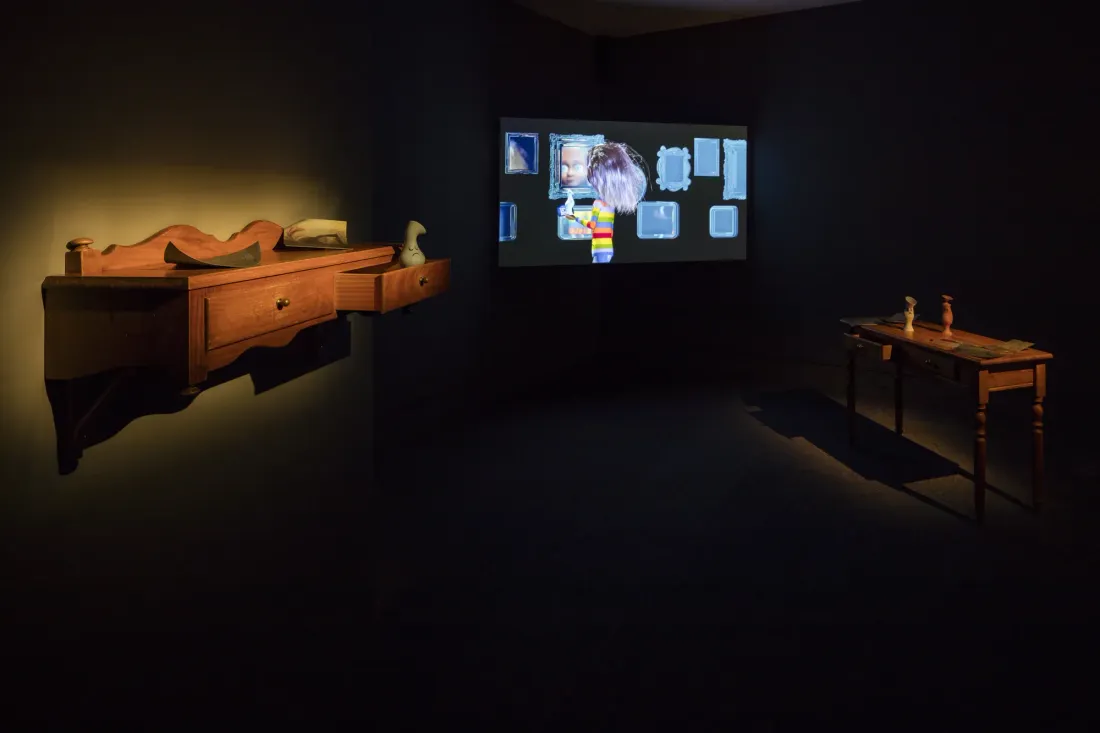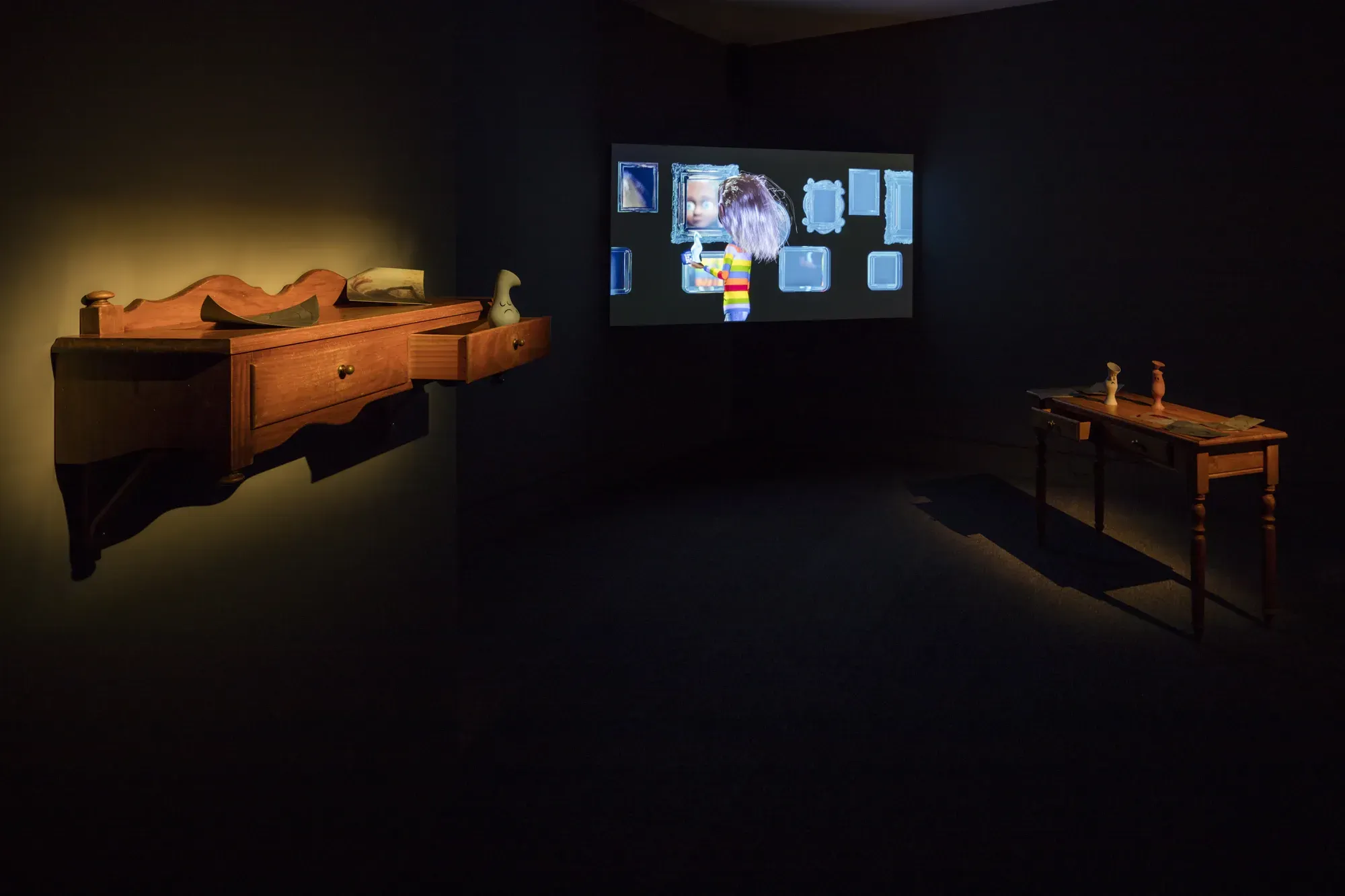Stop Making Sense
Written by


Much has been made of the rise of the curator. Increased resources and word counts privileging what the curator has to say over that of the artists they exhibit.
Should work always have to make sense as a group for us to enjoy it? Might we be given the opportunity to find some connections for ourselves? Do we need to make sense of it at all? Or in this overloaded world-wide-webbed world, where the arrangement of elements is key, do we simply want more hand holding?
In truth the most interesting group exhibitions have long been those where a curator brings together work under a vital appealing theme, but they always serve the work. At times the curator’s concept is simply a Trojan Horse to shepherd into the gallery an eclectic range of fantastic work they’ve liked (more honest exhibition title: ‘Some Current Favourite Things’). But then there are the shows where the curator is either throwing up some smart concepts in front of the work that you’re going to need to spend some time unpicking, or doing some clever stitching between them for those ideas to leach out more slowly..
Curator Stephen Cleland’s first exhibition at the Adam Art Gallery Inhabiting Space is, in the main, an example of the latter. Its light enough in its broad theme to allow you to find your own way, yet the more you think about it afterwards the more you’re struck by some of the resonances and the way Cleland makes you think of the works’ active, distilled and minimal play with space. The trick is they hopefully feel as much your discoveries as the curators - even if he thought of them first.
In many ways Inhabiting Space is a conservative show - being exactly what you expect an Adam Art Gallery show under Director Christina Barton to feature. An ultra minimal and formal restrained aesthetic? Check. A major work by a seminal but largely unknown in New Zealand post-object sculptor, trained in the late 1960s? Check (the fabulous enormous yarn work ‘Untitled (Triangle with Broken Leg)’’ by Fred Sandback). A show that explores how work might play in new ways with the interesting spaces of the Adam Art Gallery as a new form of drawing? Check. Some cool local so-called ‘post-internet’ video practice layering language and image? Check (Juliet Carpenter, with Evangeline Riddiford Graham). Julian Dashper? Check (a smart homage to Fred Sandback in being even more minimal. The late Dashper met Sandback before he died and then evolved this work while he faced his own health battles).
On the one hand you might hope from a new curator at the Adam something entirely different. On the other we can be satisfied to have someone carry on sensitively the good work the Adam. Cleland has previously curated shows that demonstrate his care and knowledge in this post-object area.
And, conservative because in a way the show feels largely like it isn’t about anything other than it’s relationship to art history, the language of art and empty space. In the way each of these works flexibly tests out a space they could be enacted absolutely anywhere - Cleland’s smart, if rather dry point.
The Sandback and Dashper connection feels like the starting place for the exhibition. And then there is a beautifully light-weighted sounding-out of the space by the pairing of a wall text work by Mike Parr (distinguished by how he plays with making you conscious of yourself in relationship to the room, when that room could be anywhere), and a video and sound work by Campbell Patterson. It’s quite the curatorial exhibition when a little known early 70s work by an Australian artist famous for a different kind of work is revived and paired with a work by a young New Zealand artist’s work seen at Michael Lett Gallery. Juliet Carpenter’s work meanwhile I found much hard to reconcile with the theme.
The greatest pleasure for me is Sriwhana Spong’s ‘The Fourth Notebook’. Yet like Carpenter it doesn’t really play with the inhabitance of the Adam space, but rather explores some of the themes internally. There is a concentrated, charged play with language through movement, camera editing and text, with delicious attention to the impact of a body on a surface – the sound of which is like chalk on a blackboard.
For many I suspect Inhabiting Space will be a very difficult show to warm to. For the smaller number intensely interested in current and past experimentation in the language of art - as befits a university gallery - it’s a show that keeps rewarding.
CURATOR AS AGENT

James Richards Rosebud, 2013 HD video, 13 minutes courtesy of the artist and Rodeo, London Photo / Sam Hartnett
Four terrific, interesting artworks form Andrew Kennedy’s exhibition The Non-Living Agent at Te Tuhi in Pakuranga: two Auckland commissions, and two outstanding recent European works. But entering the exhibition Kennedy’s work as an artist turned curator does get in the way a little. The opening paragraph of the show information starts: “Can an image plane be traversed like the threshold of a building, moving from inside to outside and back again?” As a starter that’s pretty hard to traverse.
Once past the opening paragraph, the rub of the exhibition turns out to be a rather engaging exploration of “the effects images have on our body, our sense of belonging and relationship to others.” A welcome concept given how numbed and dumbed we become to the richness and preciousness of the image in the flood we now receive.
As artist Kennedy has long been interested in how the design of an installation space affects our reading of an image. He’s now taken the natural step of extending that concept into curating his first Te Tuhi group exhibition.
The lead work is arguably the terrific Turner Prize nominated ‘Rosebud’ by James Richards, in which the dangerous sensuality of the surface of an image – the eroticism of touch - is exquisitely explored in an abstract dance between Richards own black and white footage, images of sandpaper-censored art images from a Tokyo library, the physical and mechanical instruments of viewing and a blistering soundtrack. I found myself recalling how much more charged the encounter with a photographic plate in a book was as a child.
In Mathieu Kleyebe Abonnenc’s ‘An Italian Film (Africa Adido)’ I almost felt a stab of pain when observing Yorkshire foundry men grinding off the wings of copper crosses which were treasured currency and talisman once in the Congo. In the voiceover Yorkshire children read aloud as they cut: “The future is now dead, the past unimaginable… death without burial.” A powerful commentary on the violence of colonialism, the complexity here comes not from the artist’s reference to a 1966 Italian Documentary as found in the title – which only distracted – but the powerful respect the artist pays to the Yorkshire men’s own long undertaken rituals of making, as they repurpose the copper.
Bronies is the name given to adult lovers of My Little Ponies. Sorawit Songsataya’s ‘Bronies’ is a stunning evocation through the interrelationship of 3D animation, and sculpture and painting in the gallery of the way as we go through adolescence we animate our desires through toy characters, and the way art might explore how that animation can take us into darker, less readable spaces. A girl passes by a series of differently shaped glinting mirrors. At other times they contain drawings for sexualized animations of cartoon icons, which are also presented on warping steel cards we and she might choose from on a dresser. They sit alongside 3D printed vases, which in the film buckle and puff as kindly dwarf-like guardians.
With some key use of sound effects and lighting the work plays delightfully off the tropes of an early Disney installation with its promise that its characters will be there for you for life. They may just lead you astray. Meanwhile a strange creature clothed in synthetic hair appears in the film, representing the lost child within.
In the midst spatially of these three works, on paper Dorota Broda’s ‘Cathedral’ should work beautifully. During workshops during the exhibition ‘s run the public are asked to paint whilst blindfolded a portrait of someone else by touch: one hand touching their face the other on the paper. When I attended however there was no workshop and instead the furniture from the community art side of the centre (itself an interesting movement) was empty. The rather uninteresting results of previous participants drawings left to litter the exhibition’s central space. What sounds like a warm and intriguing dialogue between the aesthetics of drawing and closeness of touch in workshop, becomes a hurdle to surmount entering the exhibition at other times. A different form of presentation would have better evoked sensation and memory.
Still, an impressive first Te Tuhi exhibition from Kennedy I’d encourage you to make the trip to see.
- The Non-Living Agent, until 24 July, Te Tuhi, Pakuranga
- Inhabiting Space, until 17 July, Adam Art Gallery, Wellington